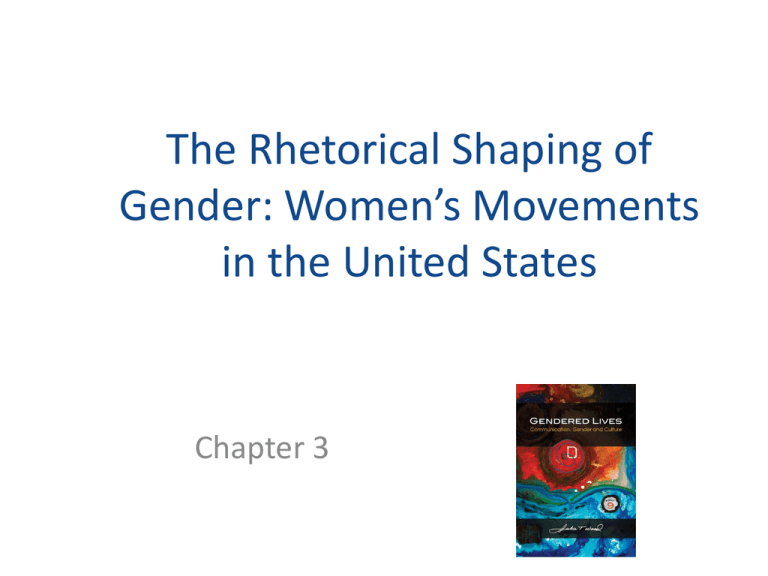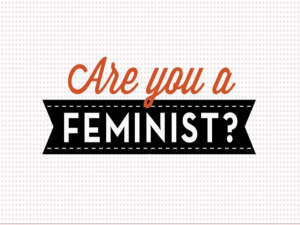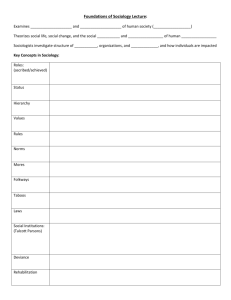Powerpoint - www.micheleweber.homestead.com
advertisement

The Rhetorical Shaping of Gender: Women’s Movements in the United States Chapter 3 Women’s Movements in the U.S. • Rhetoric is persuasion • Rhetorical movements are collective efforts to challenge and change existing: – Attitudes – Laws – Policies The Three Waves of Women’s Movements • Rhetorical women’s movements have occurred in three waves The Three Waves of Women’s Movements • Two ideologies have informed: – Liberal feminism – women and men are alike and equal – Cultural feminism – women and men are fundamentally different The First Wave of Women’s Movements • 1840-1925 • Liberal and cultural branches The Women’s Rights Movement • Activism aimed at enlarging women’s political rights • Demand for voting rights for women The Women’s Rights Movement • 1918-1920 – Paul and Burns spearheaded nonviolent protest – Women’s suffrage – Hunger strike • See clips from Iron Jawed Angels at: – http://iron-jawed-angels.com/ The Women’s Rights Movement • 1840 – Mott chosen as representative to World Anti-Slavery Convention – Not allowed to participate • Mott and Stanton worked to organize first women’s rights convention – Seneca Falls Convention - 1848 The Women’s Rights Movement • Declaration of Sentiments – Modeled on Declaration of Independence – Grievances women had suffered The Women’s Rights Movement • Men and women signed petition • Initially links with Abolitionist movement – These ties dissolved The Women’s Rights Movement • 1870 – 15th Amendment ratified – Black men won right to vote • 1920 – women gain right to vote The Cult of Domesticity • 1800s – did not ally with women’s rights movements • True ideal of womanhood – to be domestic • Participated in efforts to: – End slavery – Ban alcohol – Enact child labor laws The Cult of Domesticity • Needed right to vote to have voice in public life • Women and men not alike • Women’s virtue would reform politics The Cult of Domesticity • Securing voting rights did not immediately fuel further efforts • Few women voted • 1925 – amendment to regulate child labor failed to be ratified The Cult of Domesticity • Movements dormant for 35 years • Attention concentrated on world wars – Women joined labor force to support war effort – Women’s opportunities shrank post-war • Some women did affect change The Second Wave of Women’s Movements • 1960-1995 – second wave • Liberal and cultural ideologies coexisted • Diverse goals and rhetorical strategies Radical Feminism • Also called women’s liberation movement • Grew out of New Left politics – Protested Viet Nam war – Fought for civil rights • New Left men treated women as subordinates Radical Feminism • 1964 – women in SNCC challenged sexism in New Left – male members unresponsive • 1965 – women in SDS also found no receptivity • Many women withdrew and formed own organization Radical Feminism • Basic principle – oppression of women is fundamental form of oppression on which others are modeled • Relied on “rap” groups – Ensured equal participation Radical Feminism • Revolutionary politics • Public events Radical Feminism • Continues in the U.S. and other countries: – Missile Chick Dicks • http://www.missiledickchicks.net/ – Radical Cheerleaders • http://radcheers.tripod.com/ – Muslim feminists Radical Feminism • Identification of structural basis of oppression – The personal is political • Women’s health movement Lesbian Feminism • Radicalesbians • Only women who love and live with women putting women first • Lives not oriented around men • Lesbianism – Positive, liberated identity Lesbian Feminism • Not all lesbians are feminists • Not all lesbian feminists are Radicalesbians – Defined as women-identified • Commitment to end discrimination • Use voices to respond to criticism • Adopt proactive rhetorical strategies Separatism • Communities where women live independently with mutual respect • Many, but not all, are lesbians • Believe women are different from men • Community where feminine values can flourish Separatism • Impossible to reform patriarchal culture • Exit mainstream society • Exercise little political influence Revalorism • Focus on appreciating women’s traditional activities • Draws on standpoint theory • Women more nurturing, cooperative, lifegiving • More complete history of America Revalorism • Re-covering women’s history • Exhibits of women’s traditional arts • Debate to secure legal rights Ecofeminism • Launched in 1974 – La Feminisme ou la Mort • Connection between efforts to control women and quest to dominate nature Ecofeminism • Oppression imposed on anyone/anything that can’t resist • Includes animal rights, peace activists, and vegetarians • Seek to bring consciousness of humans’ interdependence with other forms of life Ecofeminism • Learn more at: – http://eve.enviroweb.org/ – http://www.ecofem.org/ Liberal Feminism • Advocates equality in all spheres of life • Mid-1900s – white, middle-class women living American dream • Not happy • Wanted identity beyond home Liberal Feminism • Betty Friedan – The Feminine Mystique – Named problem of dissatisfaction – Defined as political issue – Institutions kept women confined Liberal Feminism • Women and men alike • Women entitled to equal rights • NOW – National Organization for Women – 1966 – Effective in gaining passage of laws and policies – Enlarge and protect women’s opportunities Liberal Feminism • Rhetorical strategies include lobbying, public forums, drafting legislation, conventions • Criticized – Focus narrow – white, middle-class – Now more attention to diverse women Liberal Feminism • Not confined to U.S. – Spain – Muslim women – Third World – India – Iraq – Kuwait Womanism • Believe men and women mainly alike • Differentiate from white feminists • 1970s – African American women – Black Women Organized for Action – National Black Feminist Organization Womanism • Highlight ways gender and racial oppression intersect • Black women more often – Single – Less formal education – Bear more children – Paid less – Assume financial responsibility Womanism • Address issues that affect lower-class African American women – Reforming social services – Increasing training and job opportunities • Rhetorical strategies include consciousness raising and support groups Womanism • 1997 – Million Woman March – Deemphasized media hype – Woman-to-woman sharing of experiences and support Multiracial Feminism • • • • Emphasizes multiple systems of domination Prefer multiracial to multicultural Insist race cannot be viewed in isolation Race intersects other systems of domination Multiracial Feminism • Gender does not have universal meaning • Meaning of gender varies as a result of: – Race – Economic class – Sexual orientation Multiracial Feminism • Write and talk about more complex categories • Emphasis on women’s agency Power Feminism • 1993 – Naomi Wolf – http://naomiwolf.org/ • Self-defeating to focus on social causes of inequities • Society doesn’t oppress women • Women have power to control what happens to them Power Feminism • Stop thinking of themselves as victims • Capitalize on power of majority status • Katie Roiphe – another proponent – Take Back the Night marches – self-defeating Power Feminism • Appeals to white, successful, well-educated • Less helpful to those without privilege • Emphasis on empowerment influential in shaping third wave The Third Wave of Women’s Movements • Many second wave movements still active • Third wave has emerged The Third Wave of Women’s Movements • Draws from multiple branches of feminism • Less fully formed and uniform • Not yet found single center The Third Wave of Women’s Movements • Not extension of goals of second wave • Distinct historical location that informs politics and goals • Learn more at: – http://womenissues.about.com/cs/feminism /f/thirdwave.htm Recognizing Differences • Recognize women differ in many ways • Figuring out how to speak for group while recognizing differences Building Coalitions • Commitment to building alliances with men • Leads to understanding of intersections among forms of privilege and oppression Engaging in Everyday Resistance • Reforms won by second wave not woven into everyday life Engaging in Everyday Resistance • Goal to incorporate structural changes wrought by second wave into life – Challenging racist comments – Confronting homophobic attitudes – Examine class privilege Engaging in Everyday Resistance • Power must be rooted in personal, bodily resistance Being Media Savvy • Third-wavers media savvy • Gain information from numerous sources • Create media of own Being Media Savvy • Know how to use media to galvanize political goals • Use mass and social media to advance ideas – Tori Amos - R.A.I.N.N. • http://www.rainn.org/ – Blogs, zines, social network sites Embracing Aesthetics and Consumerism • Images of celebrities easy to find – hard to avoid • Some young women see them as role models • Embrace traditional girl culture • Embrace consumerism Embracing Aesthetics and Consumerism • May lead to commodification of own body • Pornography creates pressure for women to accept sexual images to feel liberated • Women encouraged to explore sexuality on own terms Individualism • Women are so different there can be no collective political agenda • Each woman defines feminism on her own terms – Autobiographical essays Individualism • Does not cultivate cohesive political agenda – Change is unlikely to happen • Structural change grows out of collective political action Antifeminism: The Backlash • Success of feminism led to antifeminist efforts • Backlash surfaced in response to each wave • Antifeminism opposes changes in women’s status and rights The Antisuffrage Movement • Aimed to prevent women from getting right to vote • Allowing women to vote would contradict natural roles as wives and mothers The Antisuffrage Movement • 1870s – formalized – National Association Opposed to Women’s Suffrage • Movement disbanded after women won right to vote in 1920 Fascinating, Total Women • 1970s – Marabel Morgan – Total Women • Helen Andelin – Fascinating Womanhood • Advocated women’s return to traditional values Fascinating, Total Women • Total Women stressed view of women as sex objects • Fascinating Womanhood grounded in biblical teachings • Support came from women dependent on husbands The STOP ERA Campaign • 1970s – response to 1972-73 ERA campaign • Phyllis Shlafly – feminism turning women into men The STOP ERA Campaign • Lobbied legislators • ERA would undercut men’s willingness to support children, allow women to be drafted The STOP ERA Campaign • Funded by corporate leaders and upper class • ERA not consistent with economic and political interests Surrendered Wives & the War against Boys & Men • 2001 –women should abandon quest for equality to have happy marriage • Let husbands lead family • Boys now disadvantaged in school Surrendered Wives & the War against Boys & Men • Women have gained power at the expense of men • Contrary to God’s commandments Contradictory Claims of Antifeminism • 1991 – Faludi’s Backlash • Antifeminist rhetoric defines feminism as source of women’s problems – Turned women into fast-track achievers Contradictory Claims of Antifeminism • Women have never had it so good – can have it all • But do women really have full equality?









